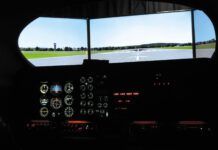Competition breeds innovation and lower prices. I think I read that a few decades ago in a business course. Sounds about right.
But the competition in pilot training hasn’t achieved that. They try to compete on quality and perhaps on price, but there’s little innovation. Of course, there is some excellent training available, but take away the fancy glass displays and plastic airplanes and we train today the same way our grandfathers might have.
If you’re old enough perhaps you remember your early days in school when the teacher taught you basic arithmetic, probably using flash cards to drill you. 2 2 = 4, 2 3 = 6, etc. It was drudgery unless you liked that sort of thing. It also inefficiently required a human to teach you.
Today, there are electronic games that make learning fun and require virtually no input from the parents who have precious little attention left for that sort of thing anyway. Why can’t our flight training have the same kind of interactive computerized instruction device? The hardware is there—Redbird and others have seen to that. The software could be designed and written, but somebody has to first replace our 100-year old training model. That requires out-of-the-box thinking in a really big way.
That new model might use the computer as a teacher, drilling you on tasks until you master them or get really stuck and need to get some additional guidance from your human instructor. That training computer—also called a flight simulator—would, of course, keep track of all your efforts and for those tasks with which you struggled the most, would often throw in drills later in your training to make sure you did, indeed, master that task.
Wouldn’t it be wonderful if you could use a home training device to actually be taught how to do all those routine things you spend hours mucking up in the airplane at probably $150 or more an hour, dual? Then, when your instructor/training coach—or the training device—says you’re ready, you actually go up in the airplane. After a couple hours you solo, and after a few more hours showing you’ve transferred that simulator-learned knowledge to the airplane, you take—and pass—your checkride. Total time in the airplane could be around 10 hours because you learned everything in that dedicated training device on the ground.
Flying is impossibly expensive for most, but wouldn’t it be great if we could at least lower the entry fee? And helicopters? Don’t even get me started about those things. I’d add helicopter to my license tomorrow if only I could afford it. If I could do most of the initial training at home with my personal heli-flight trainer, well, that’d be the answer, eh?
I had a nice chat with Jeff Van West, friend, former editor of this magazine, and now Director of Media for Redbird Flight Simulations. He tells me Redbird is working on such programs and even has a few initial products in limited use. That’s terrific, but they’re only one lone innovator, fighting alone in the wilderness. Where’s the entrepreneurial competition that’ll drive even more innovation to get it done better and faster? Anybody?
—Frank Bowlin




